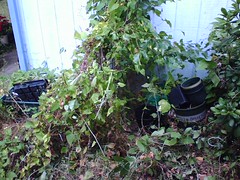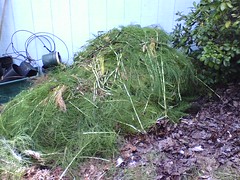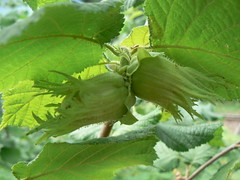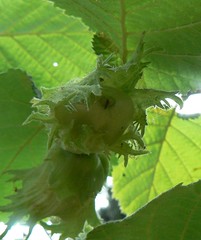 One of the first books I got when I started gardening was given to me as a gift. It was the Western Garden Problem Solver
One of the first books I got when I started gardening was given to me as a gift. It was the Western Garden Problem SolverThat would be me.
Initially, I found the book kind of entertaining, in the same gross-out way I used to find my friend Danya's father's medical books when I was a kid. You know the books I mean -- the ones with all the pictures of grotesque skin conditions and swollen body parts and lungs with cancer and whatnot. The Western Garden Problem Solver book is essentially the gardener's equivalent of those medical books, complete with photos that make you want to barf and diseases with names that sound absolutely horrific in a rather delightful sort of way (to me anyway -- I loved being grossed out!): Blackleg, Fire Blight, Scab, Shot Hole, Slime Flux, Stripe Smut, or the particularly-ominous "Sudden Oak Death." (Incidentally, it is just me, or could many of these double as pirate names?)
The more I looked through the book, though, and the more I poked around in my yard, the more unnerved I began to get. Pretty soon, I had turned into the gardening equivalent of a medical student, told to think horses when hearing hoofbeats, but thinking zebras every time anyway. Every plant in my yard suddenly had some elaborate, elusive disease. The roses had black spot and rust. The pears, I was sure, had necrotic leaf blotch. And my pink dogwood -- my favorite tree in the entire yard -- was suddenly dying right in front of my eyes from something called "anthracnose."
Despite the way it sounds, anthracnose is neither the latest al Qaeda threat, nor an extraordinarily bad 80's metal band. Instead, it's an utterly awful fungus that "causes considerable tree defoliation" and features "watery spots" with "spore masses" that contain "light pink slime."
In a word: ew.
Anyway, after finishing the book's chapter on anthracnose and then Googling the term for even more creepy information, I became utterly convinced my tree would never see another spring. Desperate, I finally broke off a small branch with infected leaves and took it into a master gardener friend of mine. Here's a transcript of our conversation:
Me: Look at this! [thrusts branch in friend's face] It's anthracnose, isn't it.
I KNOW it is. Oh god! My tree is dying of anthracnose!
Friend: [examines] Hmmm. This doesn't really look like anthracnose to me. In fact, it kinda looks like leaf scorch. How often are you watering this tree?
Me: [pauses, looks perplexed] You're supposed to water trees?
Well heck, people! Nobody ever told me that! I guess I just assumed for trees to have gotten that big to begin with in this world of sloth and iPods, they would've evolved out of the need for complimentary beverage service by now. I mean, honestly. My dandelions and blackberries never seem to need any water to flourish -- you're telling me trees can't do a better job than DANDELIONS and BLACKBERRIES? Whatever, man.
In any case, for the first six months I owned the Western Garden Problem Solver book, I showed up at my friend's door with all kinds of horrible-looking flowers and leaves, convinced every time I was single-handedly killing off every plant in my garden with some Smut or another. By the mid-year mark, she had started to roll her eyes before I even opened my mouth and finally gave MY disorder a rather apt moniker itself:
Yes, people, it's true -- the Western Garden Problem Solver (on sale at Amazon.com for only $4.99!) has turned me into a full-fledged horti-hypochondriac. Take two daisies and call me in the morning. And, my god, whatever you do, don't let the pythium root rot get you too.









